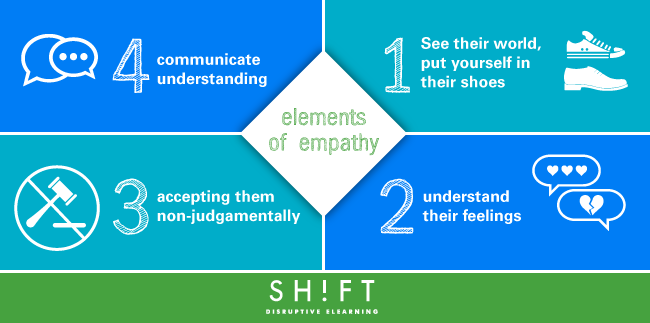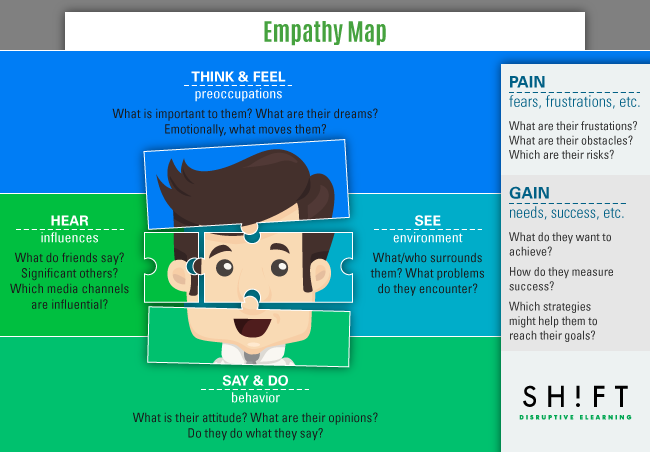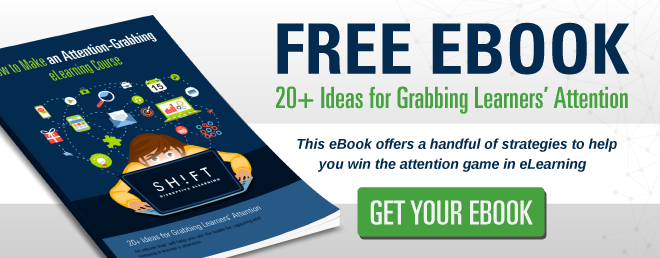Happy New Year! It is that time of the year when we get busy making resolutions. It is a time of hope and new beginnings. We resolve to lose weight, manage our time better, become more productive, and turn over a new leaf. This year, let's resolve to become more empathetic eLearning designers. We can resolve to stop churning out cookie-cutter courses, and instead, create learning material that is truly inspiring. We can resolve to stop talking down to our learners, and instead, reach out and connect with them. We can resolve to stop being aloof, and instead, show more empathy.
According to Theresa Wiseman, the four attributes of empathy are putting yourself in another person's shoes, understanding their feelings, accepting them non-judgmentally, and communicating with them to make them feel assured and cared for.

Why Should eLearning Courses be Empathetic?
According to social scientists, human beings are wired to relate to one another and feel a sense of belonging. We respond readily to affection and understanding. Advertisers understand the human psyche. The commercials that really click (read: drive action) are the ones that speak to our hearts, anticipate our deepest needs, understand our wordless desires, and provide solutions to our most pressing problems. Why should eLearning courses be any different? After all, you too want to influence and inspire your learners with your message.
In the midst of trying to apply learning theories, adhere to the course objectives, map assignments to objectives, meet deadlines, and fulfill organizational expectations, empathy usually gets the boot. That's a pity, because without empathy, you cannot make your learners trust you and believe in your message.
How Can You Become an Empathetic Instructional Designer?
Empathy as a mindset can be cultivated. With appropriate practice, it can even become your second nature. Before heading to the drawing board or defining the learning objectives, try practice being empathetic by understanding your learners.
1) Understand Your Target Audience
Demographic profiles of your target audience do not always paint the complete picture. You have to look beyond statistics like age, educational qualification, and occupation to understand the learner. Your learner is a sum total of his past experiences, desires, aspirations, and expectations. His learning styles and media preferences are shaped by his familiarity with and access to technology. His cultural upbringing influences his perception of symbols, images, words, or analogies. The learner is a complex and multi-dimensional human being; just a few numbers do not define him.
Here's how you can get into the shoes of your target audience:
- Use polls, surveys, and emails.
- Track social media habits and usage patterns. Your target audience, which comprises corporate executives, may not exactly bare their souls on social media. But you can accurately gauge the type of content that whets their imagination, stimulates their gray cells, and tickles their fancy from the posts they like and the videos they re-tweet.
- Carry out usability tests with existing courses and take down copious notes after interviewing the users.
- Use eye-tracking software to find out which screen elements grab eyeballs readily and which ones get missed.
Although it is not always possible, but if you have the chance to observe your target audience in action, grab it. For some, this might mean spending a day at the departmental store to understand what a floor manager's job entails before creating a refresher course for him! "Immerse" yourself in his world.
Pay attention to everything that is happening on the floor, so at the end of the day you know the ins and outs of the manager's work environment—the people he interacts with, his challenges, the pain points of the job, and the areas for improvement. When you "observe" his world minutely, you can figure out how you can design your course to help him improve his workplace performance.
You might also want to follow the floor manager when he steps out of the building for his lunch. No, you don't have to stalk him. Introduce yourself and get him to talk about his job and how he sees himself five years down the line. Don't expect him to come up with a learning solution, but just talking shop ("engaging") with him might give you ideas for one.
We recommend using the "Empathy Map" to analyze your learners effectively:

2) Use Appropriate Tools to Convey Empathy
You have tried to understand your learner's point of view. You empathize with him, but does he know? How can you make him believe you are a kindred spirit who has the solutions to his woes? Use the following tools:
- Images: Images are one of the most powerful design tools in your arsenal. Use images to convey emotions. Photographs of people, especially facial shots, are extremely effective in evoking emotions. That is because, we human beings like to relate to other people. However, you can also use evocative images of inanimate objects. Images of teddy bears never fail to bring out the "aww"s from us. Photographs of cozy den areas where the wooden floor is strewn with plush rugs and a crackling fire is on evoke feelings of warmth. You got the idea, right?
- Words: Use powerful verbs to convey emotions and bring alive a scene in the mind's eye of your learner. If your course has scenarios, pay particular attention to the dialogs; make them as natural-sounding as possible.
- Colors: Colors work on our brains and tickle our moods. They can even make us hungry or feel like shivering with cold! Colors can convey empathy, evoke feelings of friendliness, and make learners warm up to the course.
Empathy brings people closer and creates lasting bonds. Your learners have left their school days behind; they no longer have to learn for fear of being punished. Because your learners have a choice to take or not take your course, you have to go the extra mile to create that bond of empathy with them.
Sources:
http://designshack.net/articles/layouts/empathy-and-design-what-you-should-consider/
https://hbr.org/1997/11/spark-innovation-through-empathic-design



